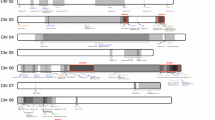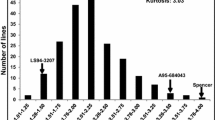Abstract
Key message
Two interactive quantitative trait loci (QTLs) controlled the field resistance to sudden death syndrome (SDS) in soybean. The interaction between them was confirmed.
Abstract
Sudden death syndrome (SDS), caused by Fusarium virguliforme, is a major disease of soybean [Glycine max (L.) Merr.] in the United States. Breeding for soybean resistance to SDS is the most cost-effective method to manage the disease. The objective of this study was to identify and characterize quantitative trait loci (QTLs) underlying field resistance to SDS in a recombinant inbred line population from the cross GD2422 × LD01-5907. This population was genotyped with 1786 polymorphic single nucleotide polymorphisms (SNPs) using SoySNP6 K iSelect BeadChip and evaluated for SDS resistance in a naturally infested field. Four SDS resistance QTLs were mapped on Chromosomes 4, 8, 12 and 18. The resistant parent, LD01-5907, contributed the resistance alleles for the QTLs on Chromosomes 8 and 18 (qSDS-8 and qSDS-18), while the other parent, GD2422, provided the resistance alleles for the QTLs on Chromosomes 4 and 12 (qSDS-4 and qSDS-12). The minor QTL on Chromosome 12 (qSDS-12) is novel. The QTL on Chromosomes 8 and 18 (qSDS-8 and qSDS-18) overlapped with two soybean cyst nematode resistance-related loci, Rhg4 and Rhg1, respectively. A significant interaction between qSDS-8 and qSDS-18 was detected by disease incidence. Individual effects together with the interaction effect explained around 70% of the phenotypic variance. The epistatic interaction of qSDS-8 and qSDS-18 was confirmed by the field performance across multiple years. Furthermore, the resistance alleles at qSDS-8 and qSDS-18 were demonstrated to be recessive. The SNP markers linked to these QTLs will be useful for marker-assisted breeding to enhance the SDS resistance.





Similar content being viewed by others
References
Ahn SJ, Costa J, Emanuel JR (1996) PicoGreen quantitation of DNA: effective evaluation of samples pre- or post-PCR. Nucleic Acids Res 24:2623–2625. https://doi.org/10.1093/nar/24.13.2623
Anand SC (1992) Registration of “Hartwig” soybean. Crop Sci 32:1069–1070
Aoki T, O’donnell K, Homma Y, Lattanzi AR (2003) Sudden-death syndrome of sobyean is caused by two morphologically and phylogenetically distinct species within the Fusarium solani species complex—F.virguliforme in North America and F.tucumaniae in South America. Mycologia 95:660–684. https://doi.org/10.2307/3761942
Brucker E, Carlson S, Wright E et al (2005) Rhg1 alleles from soybean PI 437654 and PI 88788 respond differentially to isolates of Heterodera glycines in the greenhouse. Theor Appl Genet 111:44–49. https://doi.org/10.1007/s00122-005-1970-3
Chang SJC, Doubler TW, Kilo V et al (1996) Two additional loci underlying durable field resistance to soybean sudden death syndrome (SDS). Crop Sci 36:1684–1688. https://doi.org/10.2135/cropsci1996.0011183X003600060044x
Chang HX, Roth MG, Wang D et al (2018) Integration of sudden death syndrome resistance loci in the soybean genome. Theor Appl Genet 131:757–773. https://doi.org/10.1007/s00122-018-3063-0
Churchill GA, Doerge RW (1994) Empirical threshold values for quantitative trait mapping. Genetics 138:963–971. https://doi.org/10.1534/genetics.107.080101
Cook DE, Lee TG, Guo X et al (2012) Copy number variation of multiple genes at Rhg1 mediates nematode resistance in soybean. Science 338:1206–1209. https://doi.org/10.1126/science.1228746
Fehr WR, Caviness CE, Burmood DT, Pennington JS (1971) Stage of development descriptino for soybeans, Glycine max (L.) Merrill. Crop Sci 11:929–931. https://doi.org/10.2135/cropsci1971.0011183X001100060051x
Giammaria SL, Rupe JC, Chen P, Mozzoni LA (2014) Genetic analysis of resistance to sudden death syndrome caused by Fusarium virguliforme in Hartwig Soybean. J Crop Improv 28:758–771. https://doi.org/10.1080/15427528.2014.933754
Graham PH, Vance CP (2014) Update on legume utilization legumes: importance and constraints to greater use. Plant Physiol 131:872–877. https://doi.org/10.1104/pp.017004.872
Grant D, Nelson RT, Cannon SB, Shoemaker RC (2010) SoyBase, the USDA-ARS soybean genetics and genomics database. Nucl Acids Res 38:843–846. https://doi.org/10.1093/nar/gkp798
Hartman GL, Chang HX, Leandro LF (2015) Research advances and management of soybean sudden death syndrome. Crop Prot 73:60–66. https://doi.org/10.1016/j.cropro.2015.01.017
Hnetkovsky N, Chang SJC, Doubler TW et al (1996) Genetic mapping of loci underlying field resistance to soybean sudden death syndrome (SDS). Crop Sci 36:393–400. https://doi.org/10.2135/cropsci1996.0011183X003600020030x
Holland J (2001) Epistasis and plant breeding. Plant Breed Rev 21:27–92
Hyten DL, Choi IY, Song Q et al (2010) A high density integrated genetic linkage map of soybean and the development of a 1536 universal soy linkage panel for quantitative trait locus mapping. Crop Sci 50:960–968. https://doi.org/10.2135/cropsci2009.06.0360
Iqbal MJ, Meksem K, Njiti VN et al (2001) Microsatellite markers identify three additional quantitative trait loci for resistance to soybean sudden-death syndrome (SDS) in Essex x Forrest RILs. Theor Appl Genet 102:187–192. https://doi.org/10.1007/s001220051634
Kazi S, Shultz J, Afzal J et al (2008a) Separate loci underlie resistance to root infection and leaf scorch during soybean sudden death syndrome. Theor Appl Genet 116:967–977. https://doi.org/10.1007/s00122-008-0728-0
Kazi S, Shultz J, Afzal J et al (2008b) Separate loci underlie resistance to root infection and leaf scorch during soybean sudden death syndrome. Theor Appl Genet 116:967–977. https://doi.org/10.1007/s00122-008-0728-0
Kim M, Hyten DL, Bent AF, Diers BW (2010) Fine mapping of the SCN resistance locus rhg1-b from PI 88788. Plant Genome J 3:81. https://doi.org/10.3835/plantgenome2010.02.0001
Kisha TJ, Sneller CH, Diers BW (1997) Relationship between genetic distance among parents and genetic variance in populations of soybean. Crop Sci 37:1317–1325. https://doi.org/10.2135/cropsci1997.0011183X003700040048x
Lightfoot DA (2015) Two decades of molecular marker-assisted breeding for resistance to soybean sudden death syndrome. Crop Sci 55:1460–1484. https://doi.org/10.2135/cropsci2014.10.0721
Liu S, Kandoth PK, Warren SD et al (2012) A soybean cyst nematode resistance gene points to a new mechanism of plant resistance to pathogens. Nature 492:256–260. https://doi.org/10.1038/nature11651
Liu S, Kandoth PK, Lakhssassi N et al (2017) The soybean GmSNAP18 gene underlies two types of resistance to soybean cyst nematode. Nat Commun 8:1–11. https://doi.org/10.1038/ncomms14822
Luckew AS, Swaminathan S, Leandro LF et al (2017) “MN1606SP” by “Spencer” filial soybean population reveals novel quantitative trait loci and interactions among loci conditioning SDS resistance. Theor Appl Genet. https://doi.org/10.1007/s00122-017-2947-8
Meksem K, Doubler TW, Chancharoenchai K et al (1999) Clustering among loci underlying soybean resistance to Fusarium solani, SDS and SCN in near-isogenic lines. Theor Appl Genet 99:1131–1142. https://doi.org/10.1007/s001220051317
Meksem K, Pantazopoulos P, Njiti VN et al (2001) “Forrest” resistance to the soybean cyst nematode is bigenic: saturation mapping of the Rhg1 and Rhg4 loci. Theor Appl Genet 103:710–717. https://doi.org/10.1007/s001220100597
Njiti VN, Lightfoot DA (2006) Genetic analysis infers Dt loci underlie resistance to Fusarium solani f. sp glycines in indeterminate soybeans. Can J Plant Sci 86:83–90. https://doi.org/10.4141/P05-046
Njiti VN, Doubler TW, Suttner RJ et al (1998) Resistance to soybean sudden death syndrome and root colonization by Fusarium solani f. sp. glycines in near-isogeneic lines. Crop Sci 38:472–477
Njiti VN, Meksem K, Iqbal MJ et al (2002) Common loci underlie field resistance to soybean sudden death syndrome in Forrest, Pyramid, Essex, and Douglas. Theor Appl Genet 104:294–300. https://doi.org/10.1007/s001220100682
Nyquist W, Baker R (1991) Estimation of heritability and prediction of selection response in plant populations. Crit Rev Plant Sci 10:235–322
Prabhu RR, Njiti VN et al (1999) Selecting soybean cultivars for dual resistance to soybean cyst nematode and sudden death syndrome using two DNA markers. Crop Sci 39:982–987
Roy KW, State M, Rupe JC et al (1997) Sudden death syndrome of soybean. Plant Dis 81:1100–1111
Rupe JC, Robbins RT, Becton CM, et al (1999) Vertical and temporal distribution of Fusarium solani and Heterodera glycines in ® elds with sudden death syndrome of soybean
Schmutz J, Cannon SB, Schlueter J et al (2010) Genome sequence of the palaeopolyploid soybean. Nature 463:178–183. https://doi.org/10.1038/nature08670
Shi Z, Liu S, Noe J et al (2015) SNP identification and marker assay development for high-throughput selection of soybean cyst nematode resistance. BMC Genomics 16:1–12. https://doi.org/10.1186/s12864-015-1531-3
Song QJ, Marek LF, Shoemaker RC et al (2004) A new integrated genetic linkage map of the soybean. Theor Appl Genet 109:122–128. https://doi.org/10.1007/s00122-004-1602-3
Srour A, Afzal AJ, Blahut-Beatty L et al (2012) The receptor like kinase at Rhg1-a/Rfs2 caused pleiotropic resistance to sudden death syndrome and soybean cyst nematode as a transgene by altering signaling responses. BMC Genomics 13:368. https://doi.org/10.1186/1471-2164-13-368
Swaminathan S, Abeysekara NS, Liu M et al (2016) Quantitative trait loci underlying host responses of soybean to Fusarium virguliforme toxins that cause foliar sudden death syndrome. Theor Appl Genet 129:495–506. https://doi.org/10.1007/s00122-015-2643-5
Van Ooijen J (2006) JoinMap 4. Software for the calculation of genetic linkage maps in experimental populations. Wageningen: Kyazma BV
Voorrips RE (2002) MapChart: software for the Graphical Presentation of Linkage Maps and QTLs. J Hered 93:77–78. https://doi.org/10.1093/jhered/93.1.77
Wang S, Basten CJ, Zeng Z-B (2012) Windows QTL cartographer 2.5. Department of Statistics, North Carolina State University, Raleigh, NC. http://statgen.ncsu.edu/qtlcart/WQTLCart.htm
Wen Z, Tan R, Yuan J et al (2014) Genome-wide association mapping of quantitative resistance to sudden death syndrome in soybean. BMC Genomics 15:809
Wrather JA, Kendig SR, Anand SC et al (1995) Effects of tillage, cultivar, and planting date on percentage of soybean leaves with symptoms of sudden death syndrome. Plant Dis. 79:560–562
Zhang J, Singh A, Mueller DS, Singh AK (2015) Genome-wide association and epistasis studies unravel the genetic architecture of sudden death syndrome resistance in soybean. Plant J 84:1124–1136. https://doi.org/10.1111/tpj.13069
Zhang S, Zhang Z, Bales C et al (2017) Mapping novel aphid resistance QTL from wild soybean, Glycine soja 85-32. Theor Appl Genet 130:1941–1952. https://doi.org/10.1007/s00122-017-2935-z
Acknowledgements
This work was supported by North Central Soybean Research Program, Michigan Soybean Promotion Committee, USDA National Institute of Food and Agriculture, Hatch project 1011788 and MSU AgBioResearch. We thank Randy Laurenz, Yingdong Bi, Shichen Zhang, Wenyan Du, Jiazheng Yuan, Lihong Li, Wei Xiao, and Zhimin Dong for the help in the conduction of this research.
Author information
Authors and Affiliations
Corresponding author
Ethics declarations
Conflict of interest
All authors declares that they have no conflict of interest.
Ethical standards
This work complies with the current law of the U.S.A.
Additional information
Communicated by Volker Hahn.
Electronic supplementary material
Below is the link to the electronic supplementary material.
Rights and permissions
About this article
Cite this article
Tan, R., Serven, B., Collins, P.J. et al. QTL mapping and epistatic interaction analysis of field resistance to sudden death syndrome (Fusarium virguliforme) in soybean. Theor Appl Genet 131, 1729–1740 (2018). https://doi.org/10.1007/s00122-018-3110-x
Received:
Accepted:
Published:
Issue Date:
DOI: https://doi.org/10.1007/s00122-018-3110-x




